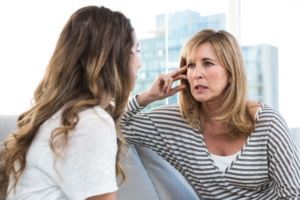How To Help An Adult Child Trapped In An Abusive Relationship

When her tragic disappearance and murder made headlines around the world, the life of Gabby Petito sparked a much-needed conversation about relationship safety. Anyone who watched footage of Gabby and Brian Laundrie stopped by the police in Moab, Utah, over a domestic violence dispute were left with questions…could more have been done to detect warning signs of abusive behavior? What legal steps can be taken to protect victims from their abusers? And, how do you help a loved one trapped in a violent relationship right now?
Domestic violence can occur in any kind of relationship, from casual and longer-term dating relationships to marriage partners. Domestic violence crosses lines of sexual orientation, income bracket, race and ethnicity. No one is exempt.
If you suspect that your adult child is in an abusive relationship, bringing up your concerns is important. With that said, it’s a difficult conversation. You can open the lines of communication by going in with a plan:
Learn common signs and symptoms of domestic violence. Knowing the signs can help you be specific in voicing your concerns with your child. “I noticed you have bruises on your upper arm.” (Physical abuse) “You have stopped coming home for our weekly supper.” (Abuser isolating victim from family) “You quit your job without telling any of us” (Possible signs of financial abuse or hiding injuries from co-workers) Being direct and specific about your concerns can be an opening for a more direct and honest response. If your child gives an evasive answer, you can follow up by letting them know that you are concerned because what you have noticed is a sign of domestic abuse and that you are there to help.
Provide your child with a Safety Plan. As part of your conversation with your child, encourage your child to create a Safety Plan that outlines what to have prepared and what to do before leaving the abusive relationship. The safety plan generally includes:
- a list of people to call and things to do once safely away from the abuser.
- a list of items to pack before leaving, if possible.
You can download our free Domestic Violence Safety Plan PDF to give to your child. Have them keep it in a safe location.
Help your adult child explore their legal options. Victims of abuse often feel isolated and trapped, so a big part of your job may be educating your adult child about available legal resources and protections.
Frontline legal measures for victims of domestic violence include:
- Temporary restraining orders. This is an order of protection that prevents abusers from having contact with victims for a certain period of time. A judge may convert a temporary order into a final (permanent) order of protection after a formal hearing. Be prepared that you may be called on to give testimony as a witness to the abuse. Start keeping records of what you notice and when it occurred. Victims may go directly to their local courts to file for a restraining order, or go through their local police department. Tip: Check the courts for Covid-related closures or changes in access; police stations are generally always available.
- Safeguarding children. When the abuser and victim have children together, the victim can request a temporary order of sole custody. Depending on the circumstances, the court can prevent all contact between the alleged abuser and a child or may allow only supervised visitation. If the victim parent cannot assume sole custody, grandparents may be given temporary guardianship of the children.
- Obtaining money to live. Victims can apply to the courts for temporary alimony and temporary child support at the same time they file for a restraining order. No contact with the abuser is needed to obtain support payments. Victims may need help budgeting to ensure that expenses such as groceries and rent are met.
- Special help for financial abuse. In the vast majority of domestic violence cases, abusers exert financial control through means such as forcing victims to turn over their paychecks, giving victims an “allowance,” or demanding receipts for even the smallest of purchases. The courts can help victims restore access to joint accounts. You may again be an important witness that can inform the courts about the extent of the abuse.
- Divorce and separation. When a victim decides to end an abusive marriage, separation and filing for divorce are the next logical steps. The divorce process involves dividing marital assets, including retirement plans and the family home. Final decisions about alimony and child custody must also be determined. You can help by tracking down a divorce attorney who offers free consultations and has experience with domestic violence. You can even attend attorney meetings if your daughter agrees.
What you can do to help your child right now
Think practically: consider buying them a separate cell phone with a private number. Most pay-as-you-go phones can be discreetly set up. You can also help by documenting all instances of domestic violence, including taking photos, making notes of places and times, and recording names of any other witnesses. Make sure they have the number for the National Domestic Violence Hotline at 1–800–799–7233 (SAFE).
The pandemic is a high risk time where victims of abuse may feel more isolated than ever. So most of all, send your child the clear message that you are their safe person. Let them know that when they are ready, that you will be with them every step of the way.
Do you or a loved one need legal protection in a domestic violence matter? We can help. Learn your rights and get answers to all your questions by scheduling a consultation with a trusted family law attorney. Call us at 888-888-0919 or click the button below to get started.



